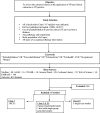Effects of telerehabilitation in occupational therapy practice: A systematic review
- PMID: 31217758
- PMCID: PMC6560836
- DOI: 10.1177/1569186119849119
Effects of telerehabilitation in occupational therapy practice: A systematic review
Abstract
Objective/background: This study aimed to review the current evidence on the application of telerehabilitation in occupational therapy practice and its clinical outcomes over the last 10 years.
Methods: A systematic review was performed on studies published in English in the decade 2008 to 2017, retrieved from seven electronic databases (MEDLINE, Cochrane Library, CINAHL, Web of Science, SAGE, Science Direct and EMBASE). Only articles evaluating the use of telerehabilitation to provide occupational therapy services from a distance were included, with no restrictions on pathology, impairment, age, or the nature of occupational therapy intervention.
Results: Fifteen articles (three randomised controlled trials, eight quasi-experimental studies, one trial with single-group post-intervention and three case studies) were reviewed. Despite various study designs and outcome measures, most studies indicated positive therapeutic effects of using telerehabilitation in occupational therapy practice. There is insufficient evidence, however, to confirm that telerehabilitation is more effective than the face-to-face model. Little evidence was shown on the long-term effect and cost efficacy. Only two studies used smartphones in their applications.
Conclusion: Telerehabilitation offers an alternative service delivery model for occupational therapy, not only bridging distance but also offering user-friendly treatment for patients at home. Further research, particularly on the use of the most cutting-edge mobile technology, is needed to determine effectiveness in occupational therapy practice treating various diseases, conditions and impairments and the characteristics of patients, interventions and therapists that lead to the best fit with this alternative and emerging form of service delivery.
Keywords: Telerehabilitation; occupational therapy; systematic review.
Figures
References
-
- Amatya B., Galea M. P., Kesselring J., Khan F. (2015). Effectiveness of telerehabilitation interventions in persons with multiple sclerosis: A systematic review. Multiple Sclerosis and Related Disorders, 4(4), 358–369. - PubMed
-
- American Occupational Therapy Association. (2010). Workforce trends in occupational therapy. Retrieved from http:www.aota.org/-/media/Corporate/Files/EducationCareers/Prospective/W...
-
- Bergquist T., Gehl C., Lepore S., Holzworth N., Beaulieu W. (2008). Internet-based cognitive rehabilitation in individuals with acquired brain injury: A pilot feasibility study. Brain Injury, 22(11), 891–897. - PubMed
-
- Boehm N., Muehlberg H., Stube J. E. (2015). Managing poststroke fatigue using telehealth: A case report. American Journal of Occupational Therapy, 69(6), 6906350020 pp1–7. doi:10.5014/ajot.2015.016170 - PubMed
Publication types
LinkOut - more resources
Full Text Sources
Medical


